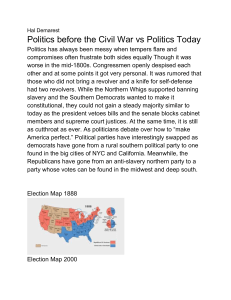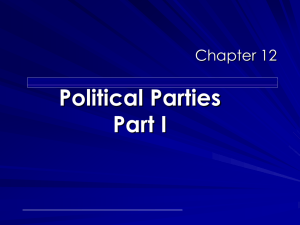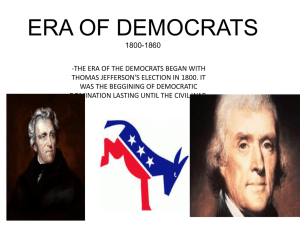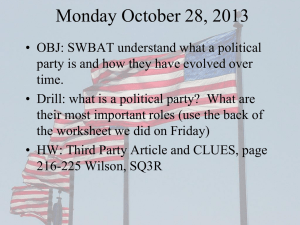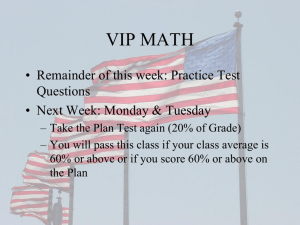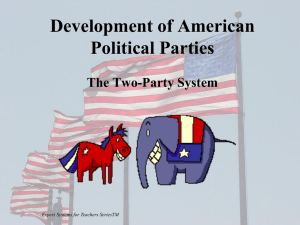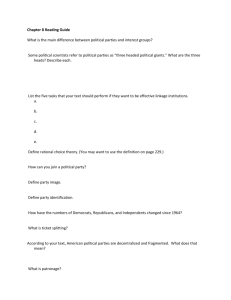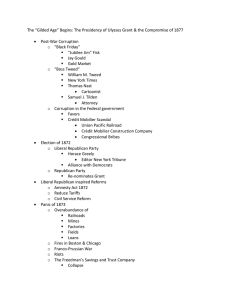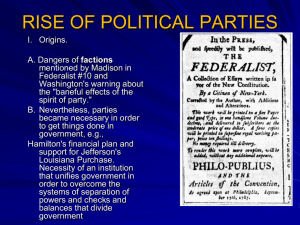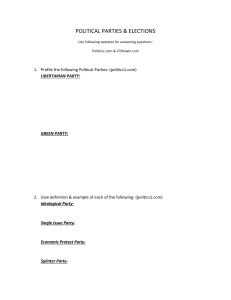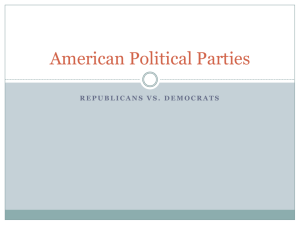Chapter 9, Section 1 Development of American Political Parties
advertisement
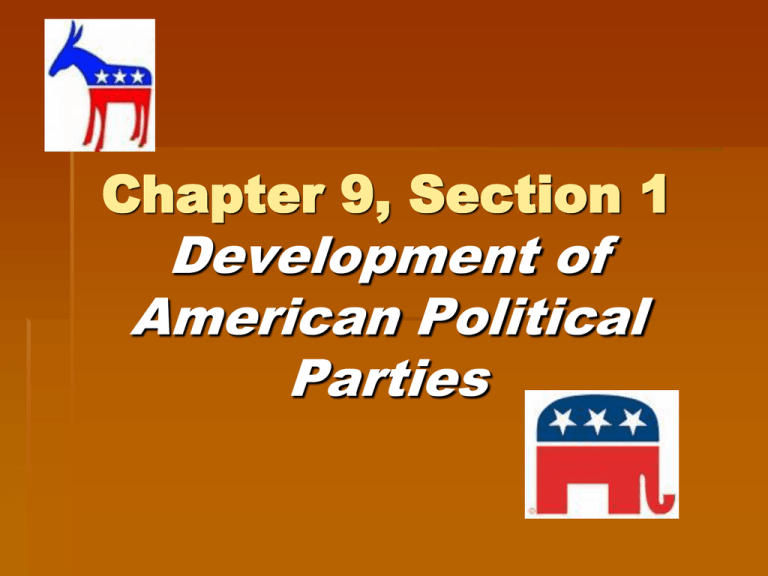
Chapter 9, Section 1 Development of American Political Parties Main Idea Shortly after our nation’s birth, political leaders formed parties in an attempt to gain control of decision making in our government. I. The Two Party System (218-219) A. Political Party- an association of voters with broad common interests who want to influence government decision making. ***Anyone may join a political party. You simply register.*** B. Two-Party System- United States has had two major parties since 1860. Dems and Reps C. Thomas Jefferson- wanted less power for the national government and more power to the states. Called his group the DemocraticRepublican party in 1828. ***In 1829 Jefferson stepped down, his party was taken over by Andrew Jackson who turned the party into our modern day Democrats.*** D. Alexander Hamilton- Wanted strong national government and a strong president. His group was called the Federalists. ***Whigs eventually took over as Federalists faded away.*** E. Whigs- Rose in 1830, Whigs and Democrats remained the two major political parties until 1850. ***In 1854, breakaway Democrats and Whigs who opposed slavery formed the Republican Party.*** ***Lincoln became the first Republican president in 1860. Ever since, Republicans and Democrats have been the two major parties!*** II. Third Parties A. Third Parties- sometimes challenge the two major parties. Have never won a presidential election. B. Populist Party- formed in the 1890s. Made up of laborers and farmers. Never won the election but their idea’s were adopted. Two main idea’s: 1. Direct Election of Senators 2. Eight Hour Work Day Third Parties in the U.S Alaskan Independence Party (1984 – present) America First Party (2002 – present) ***American Nazi Party (1959 - present)*** American Party (1969 – present) American Fascist Party (unknown - present) American Patriot Party (2003 – present) American Reform Party (1997 – present) Centrist Party (United States) (2006 - present) Charter Party of Cincinnati, Ohio (1924 – present) Christian Freedom Party (2004 – present) Communist League (US) (2004 – present) Communist Party USA (1919 – present) Covenant Party (Northern Mariana Islands) Free People's Movement (2002 – present) Freedom Road Socialist Organization (1969 - present) ***Ku Klux Klan (1866 - present)*** Cont…. ***Marijuana Party (2002 – present)*** ***Marijuana Reform Party (New York) (1997 – present)*** Mountain Party (West Virginia) (2000 – present) National Socialist Movement (1974 – present) New American Independent Party (2004-present) New Party (1992 – 1998) New Progressive Party of Puerto Rico (1967 – present) New Union Party (1974 – present) New York State Right to Life Party (1970 – present) Peace and Freedom Party (1967 – present) Personal Choice Party (1997 – present) Popular Democratic Party of Puerto Rico (1938 – present) Progressive Party of Washington (1912-1960 and 2003 to present) ***Prohibition Party (1867 – present)*** C. Progressive Party- Created by Teddy Roosevelt. Called the “Bull Moose Party”. ***He won enough votes away from Taft(R), that Woodrow Wilson (D) won.*** ***Some third parties arise to promote social, economic, and moral issues.*** D. Single Issue PartyHave only one issue in which they run on. ***Prohibitionists. Wanted the outlaw of alcohol.*** E. Ideological Parties- Focus on changing society in major ways. 1. Communist Party- favors government ownership. 2. Libertarian Party – wants more individual freedoms. 3. Green Party- Opposes power of corporations. ***Some third parties form around wellknown individuals who cannot get support from a major party.*** ***Third-Party candidates must obtain a large amount of signatures to get on the ballot*** ***. Republican and Democratic candidates are automatically placed on the ballot.*** F. Most voters favor a major party. G. Third parties have trouble raising enough money to compete with the big two. http://www.opensecrets.org/pres08/index.a sp III. Other Party Systems ***Two party systems are rare.*** A. Most democracies have multi-party systems. B. In a one-party system, the government and party are nearly the same thing. ***In China, the People’s Republic of China, is the only party ALLOWED to exist (Communist).*** ***One-Party systems also exist in nonCommunist nations. Muslim leaders control Iran’s Islamic Republican Party. Other parties are outlawed.*** IV. Today’s Major Parties ***Major parties differ mainly in their belief on how much government should be involved in your daily lives.*** A. Democrats- believe government should be more involved in regulating the economy and providing for the poor. ***Increase taxes on those who make $250+*** B. Republicans- believe that if they help the economy grow, poor people will have a better chance to find jobs for themselves. They believe in less regulation. ***trickle down economics*** ***Both parties adopt mainstream ideas and avoid extreme positions.*** C. Platform- Series of statements expressing the party’s principles, beliefs, and positions on issues. D. Plank- each individual part of a platform. Mini Quiz!!! Hot Chocolate- Winner 1. Name our two major political parties 2. What type of party system does the United States have? 3. Name two types of third parties 4. Has a third party ever won an election? 5. Name two Communist nations 6. Who was the leader of the Bull Moose Party?
